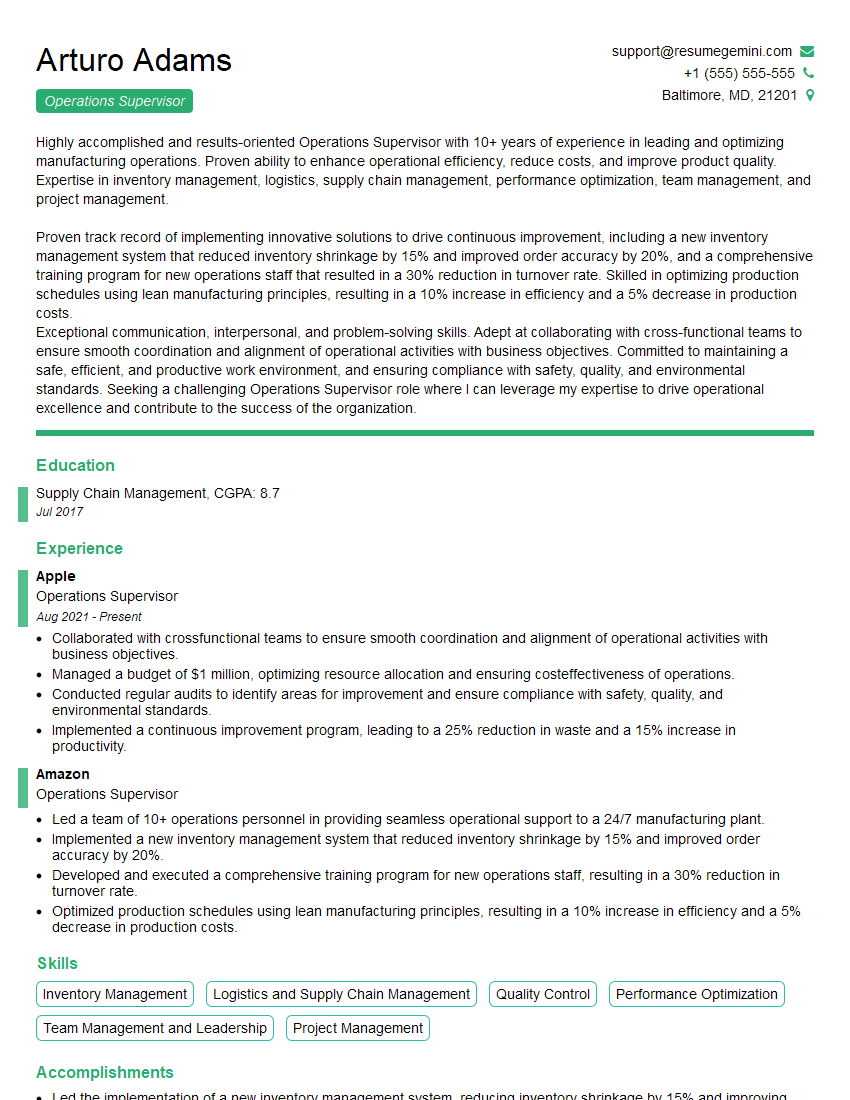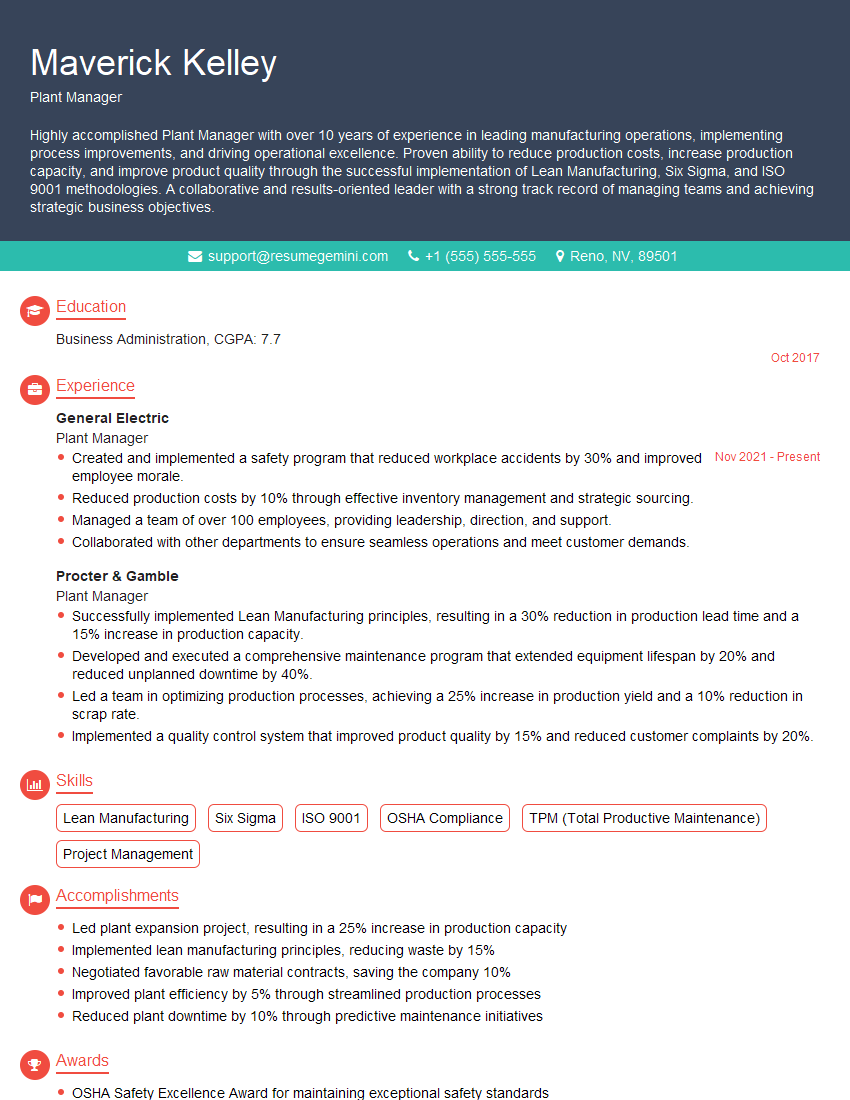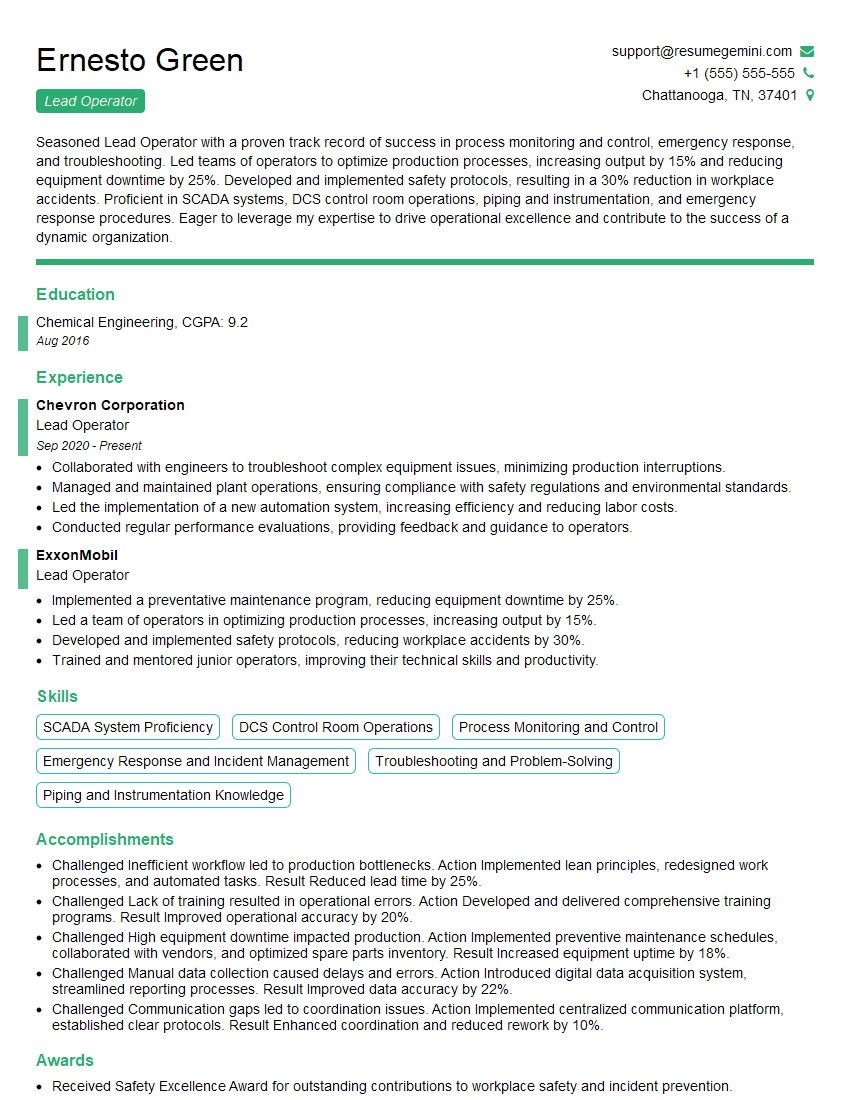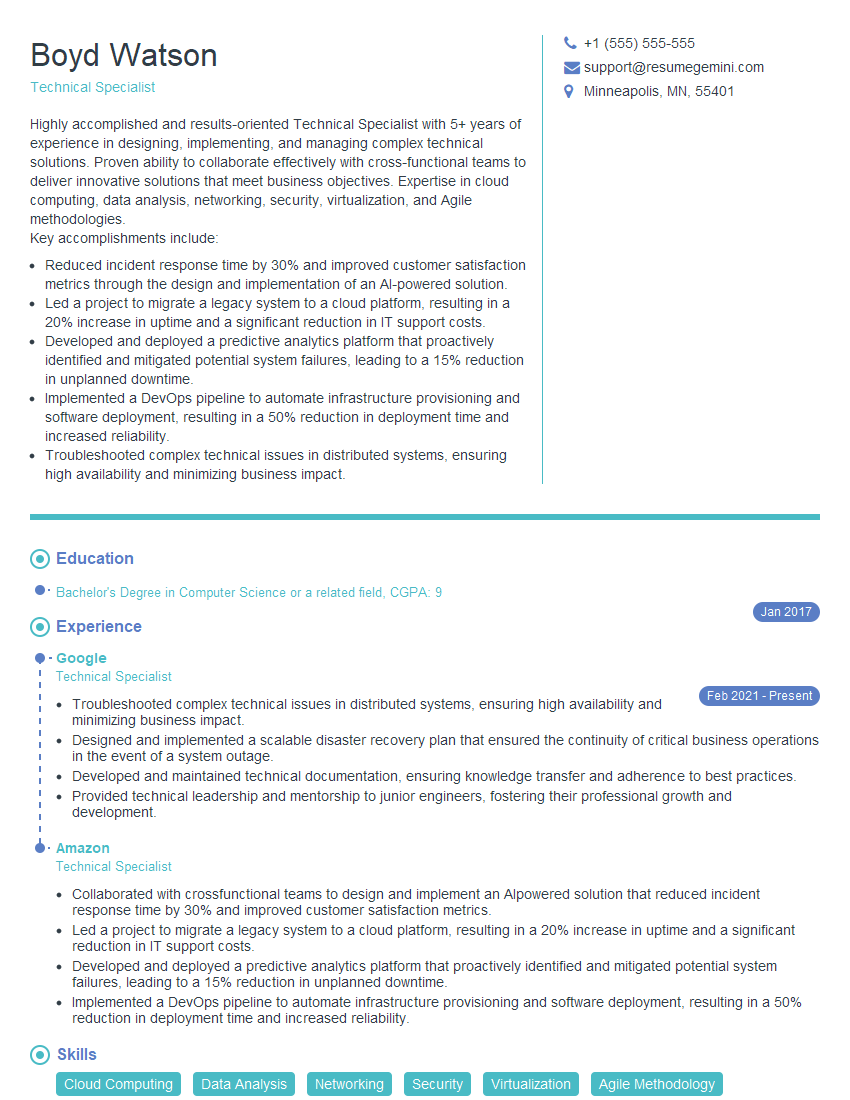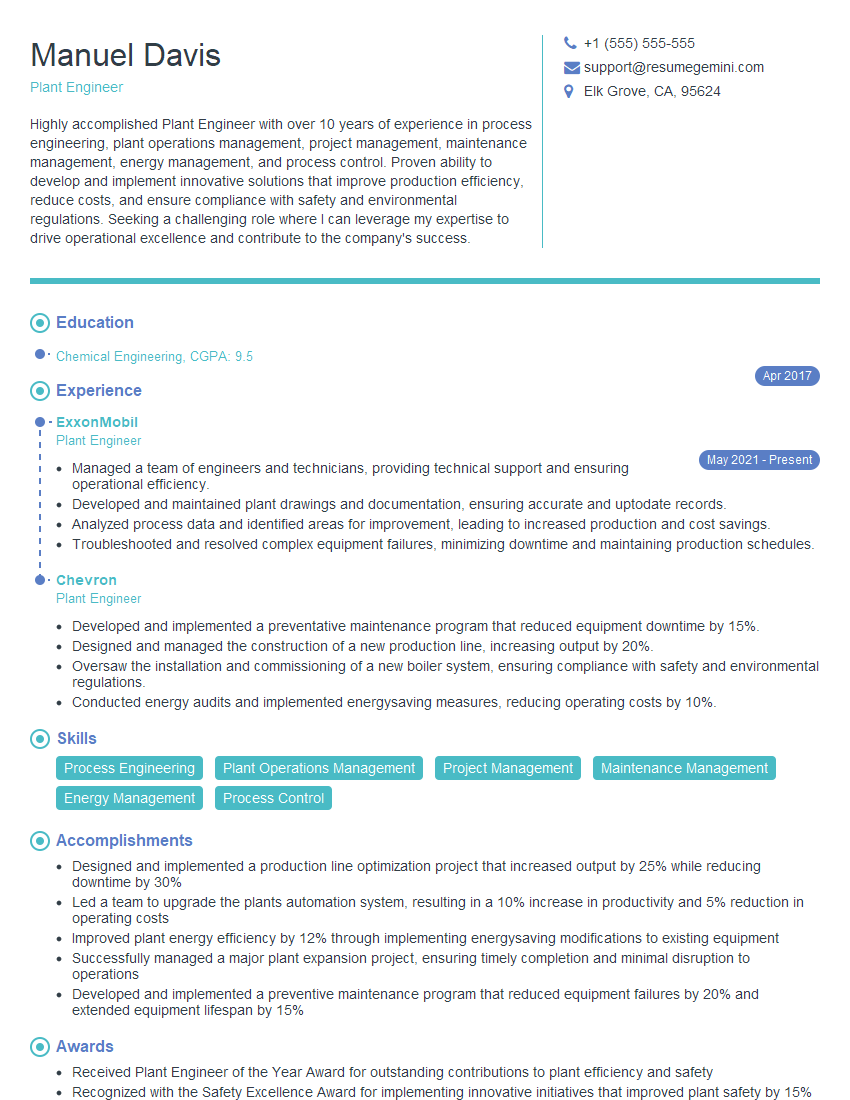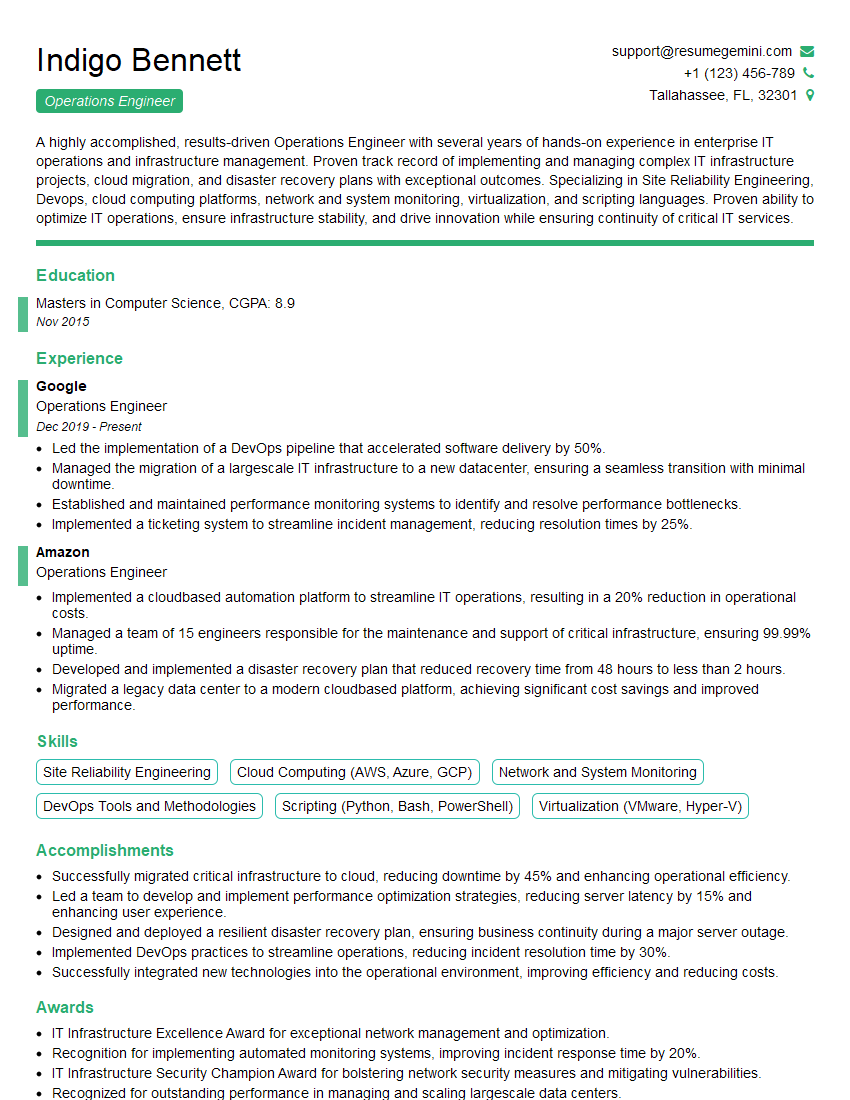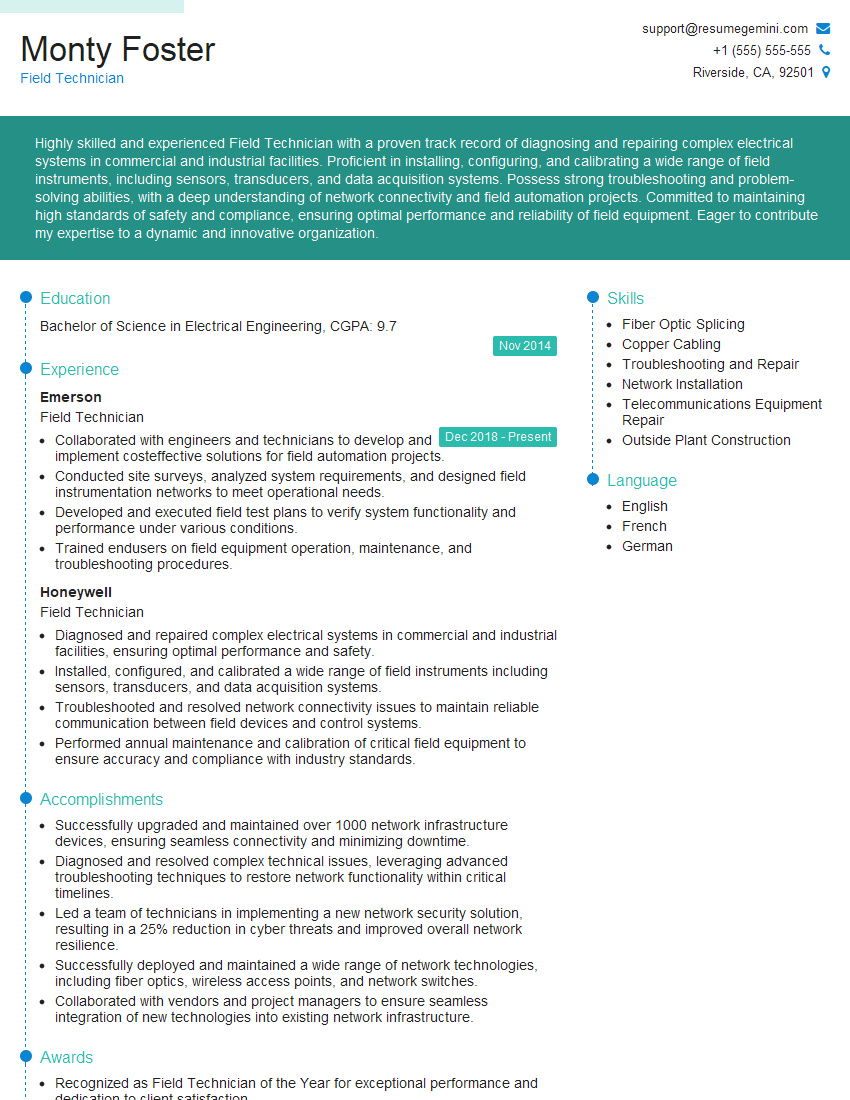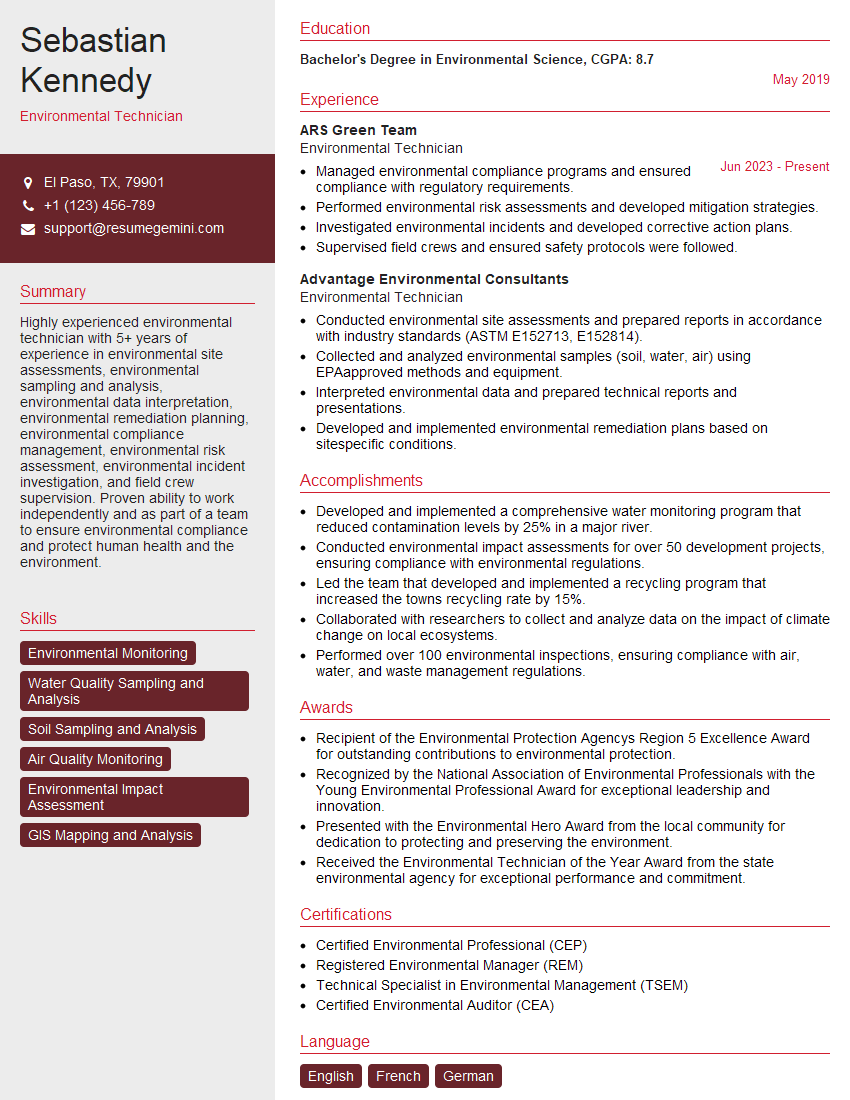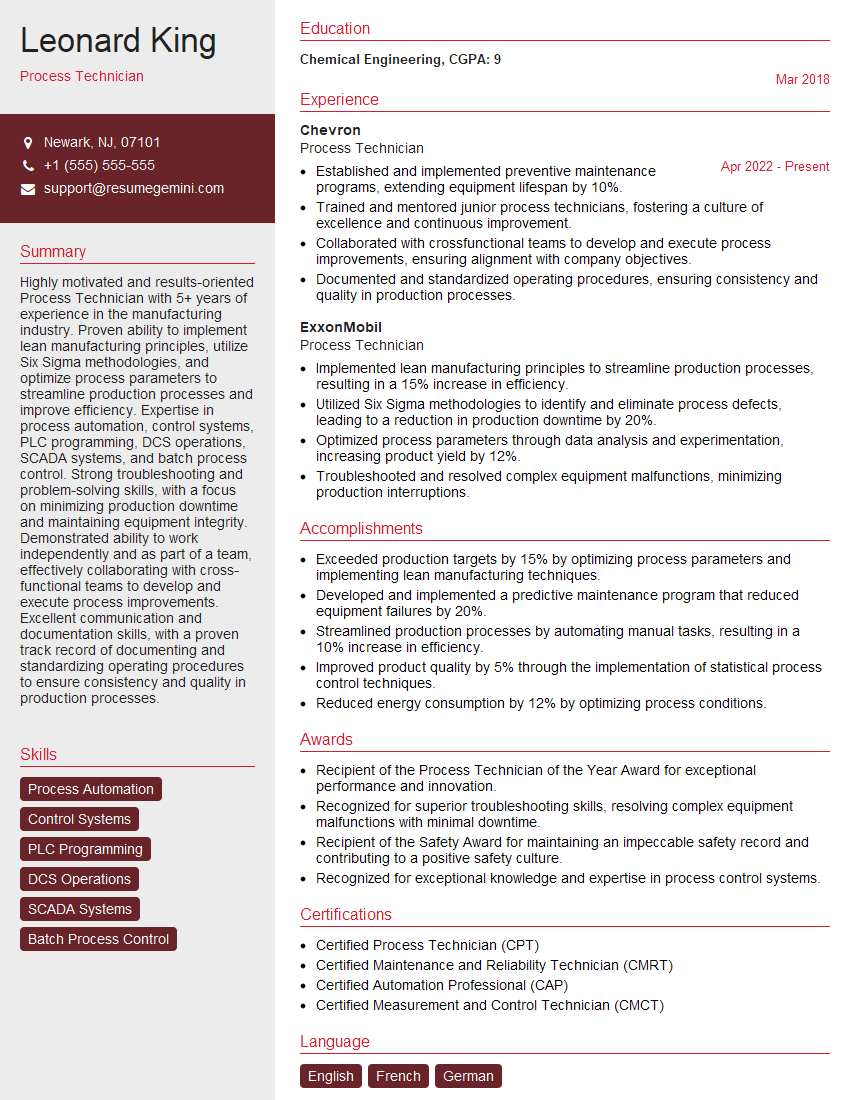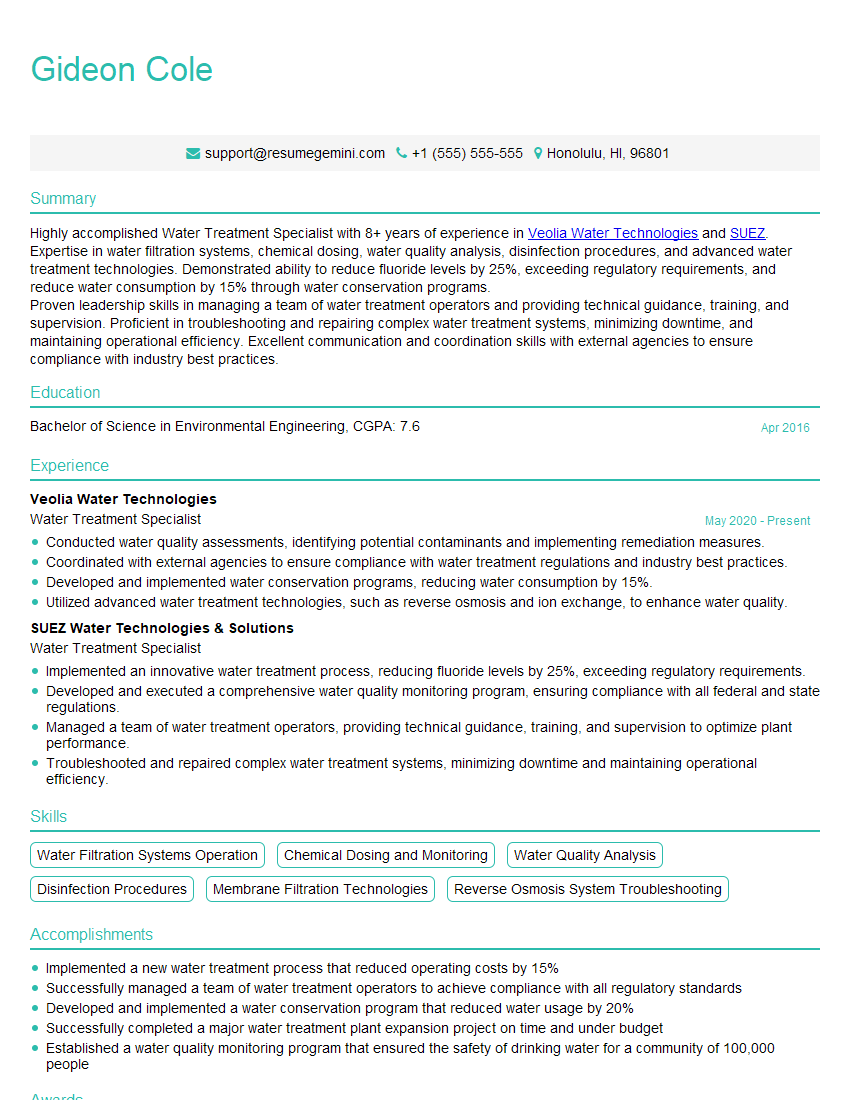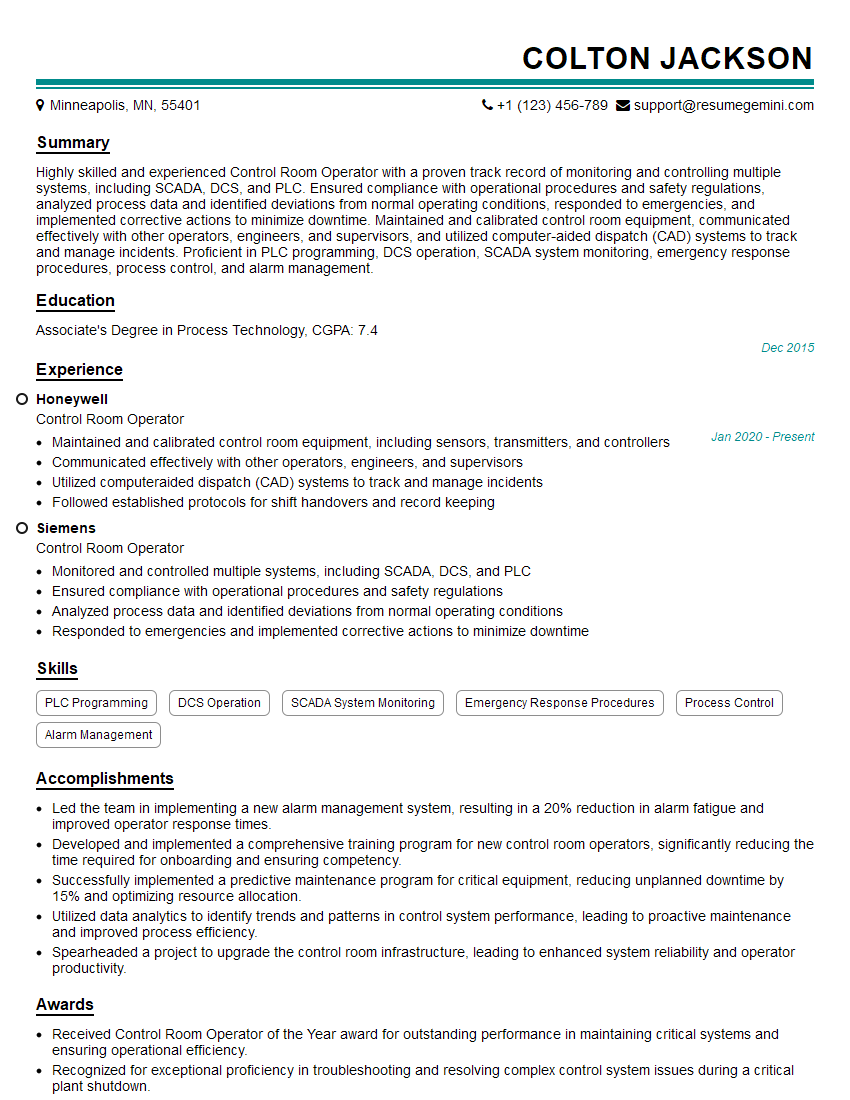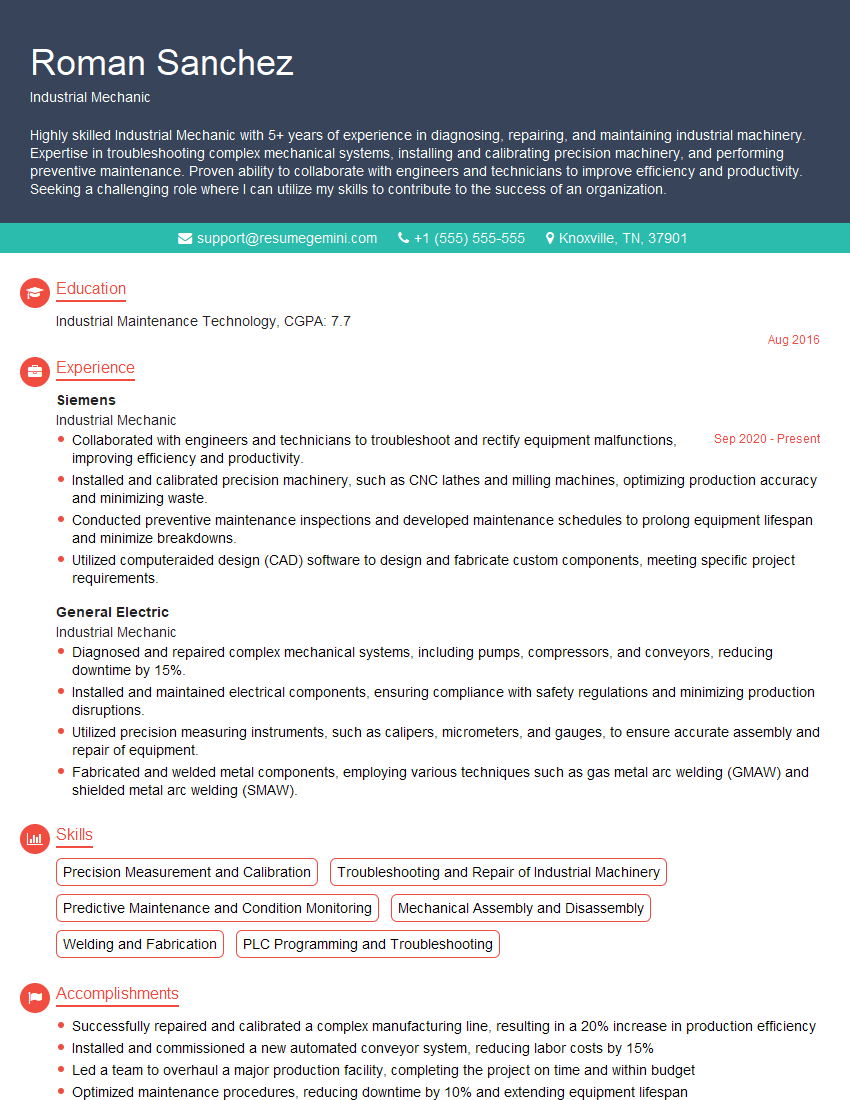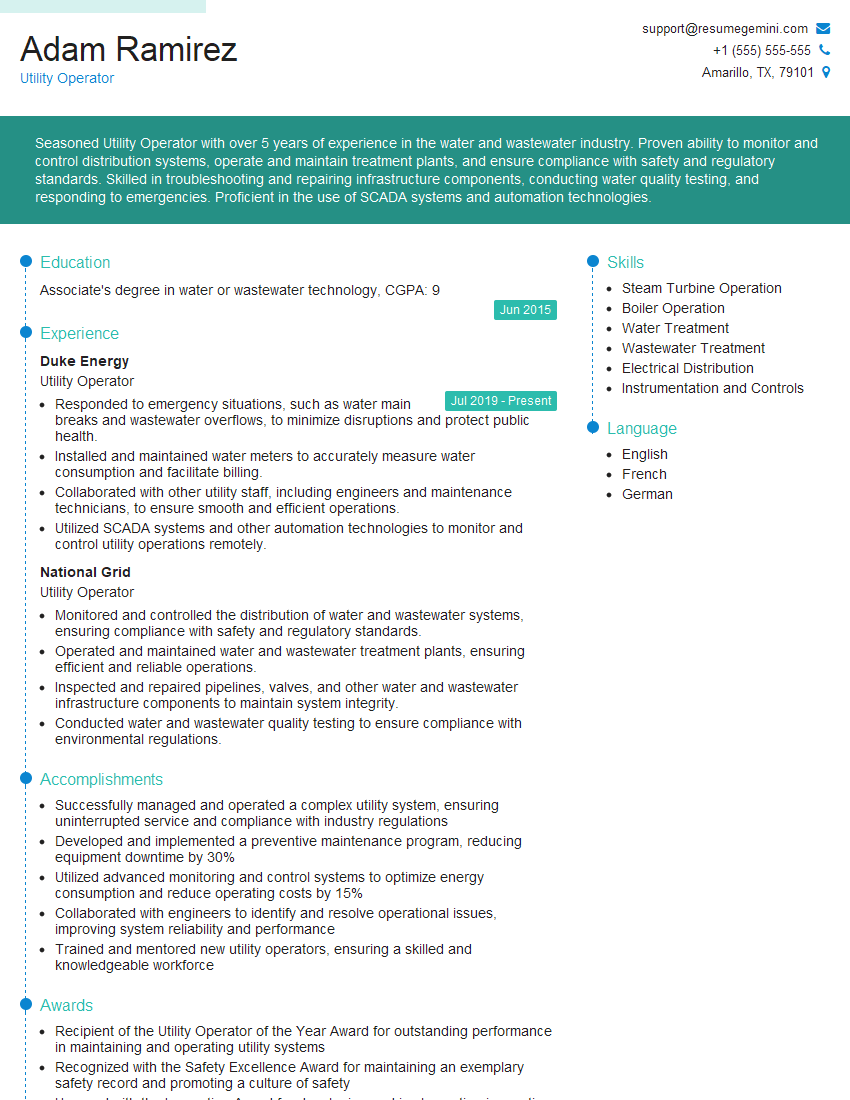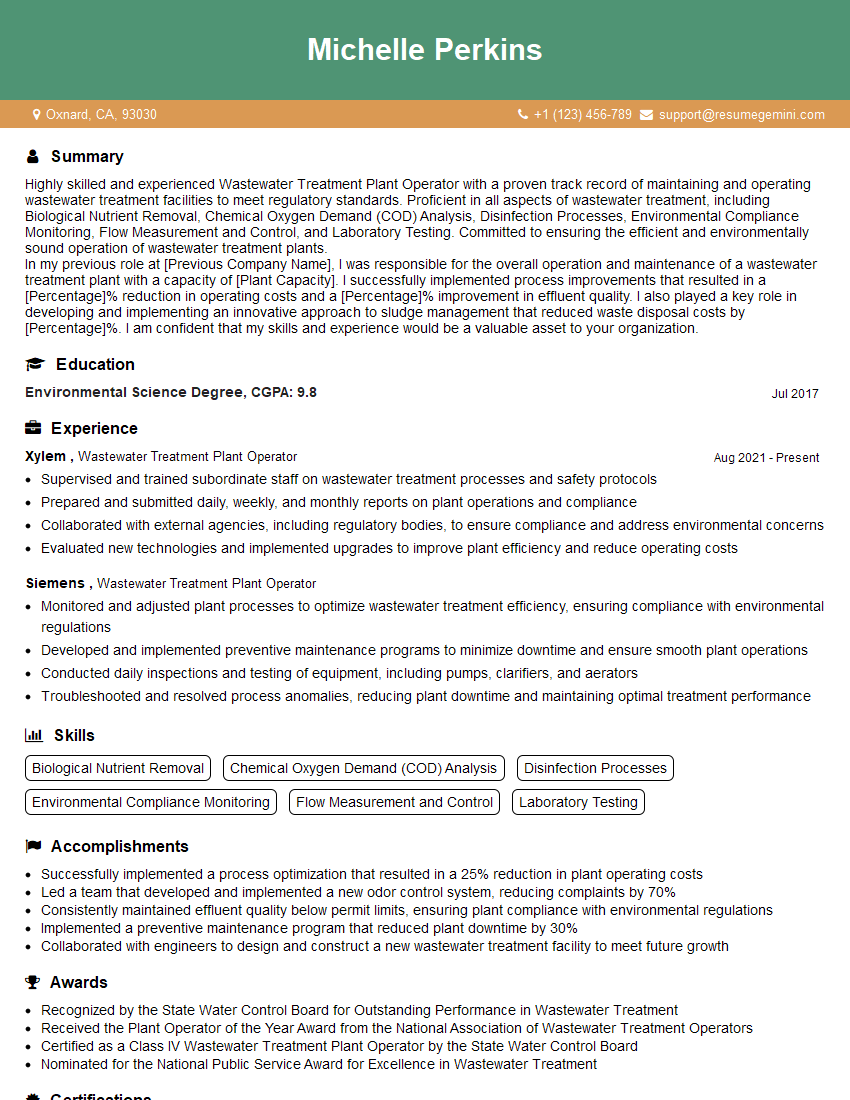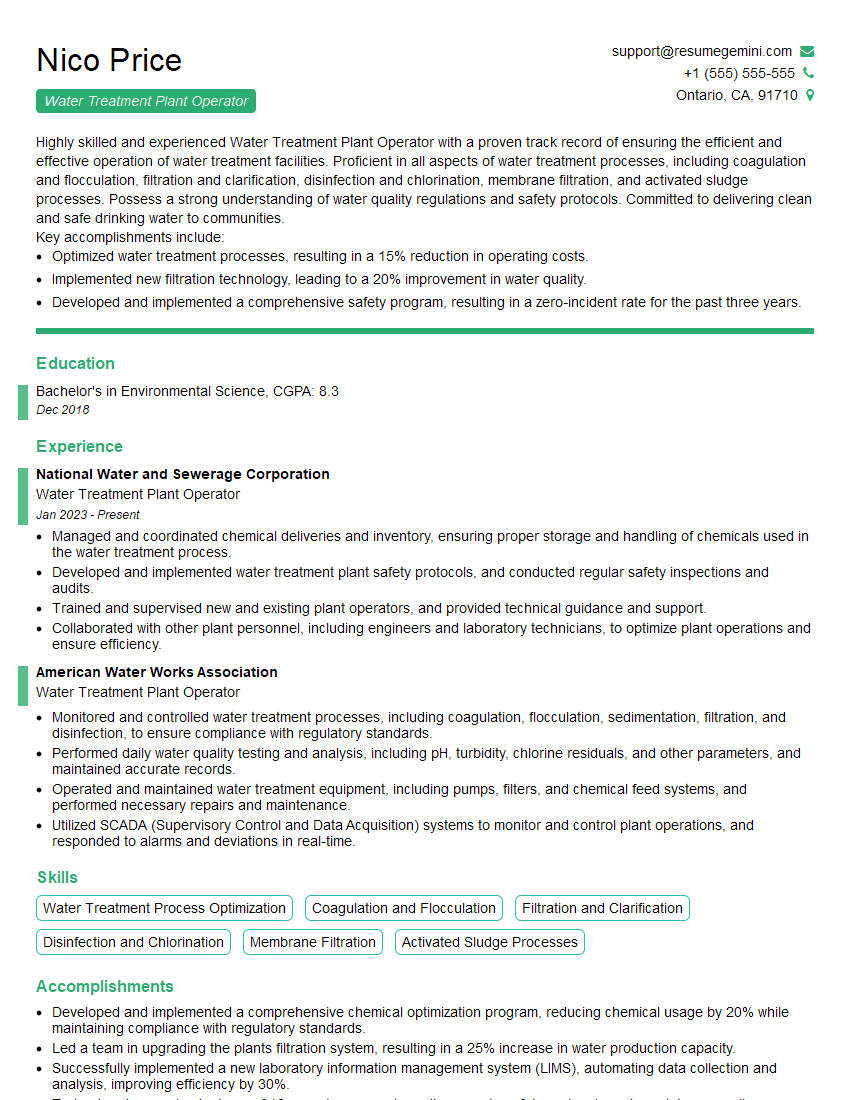Every successful interview starts with knowing what to expect. In this blog, we’ll take you through the top Operating Backwash Pumps interview questions, breaking them down with expert tips to help you deliver impactful answers. Step into your next interview fully prepared and ready to succeed.
Questions Asked in Operating Backwash Pumps Interview
Q 1. Explain the purpose of a backwash pump in a water filtration system.
The backwash pump plays a crucial role in water filtration systems by cleaning the filter media. Think of it like this: your filter is like a sieve, trapping dirt and debris. Eventually, this buildup restricts water flow and reduces the filter’s efficiency. The backwash pump reverses the flow of water, forcing it back through the filter media, dislodging the accumulated contaminants and carrying them away.
Without a backwash pump, the filter would become clogged, requiring manual cleaning or replacement, which is time-consuming and expensive. The backwash pump automates this process, ensuring continuous, efficient filtration.
Q 2. Describe the different types of backwash pumps used in water treatment.
Several types of backwash pumps cater to different needs in water treatment. Common types include:
- Centrifugal Pumps: These are the most widely used, known for their reliability, high flow rates, and relatively simple design. They use centrifugal force to move water. Imagine a spinning fan; water is drawn in at the center and propelled outwards at high velocity.
- Positive Displacement Pumps: These pumps deliver a consistent volume of water per rotation, regardless of pressure changes. They are ideal for applications requiring precise backwash flow, even when the filter media is heavily clogged. Think of a piston pump; a piston moves back and forth to displace water.
- Diaphragm Pumps: These pumps utilize a flexible diaphragm to move water. They’re particularly useful for handling fluids with suspended solids or abrasive particles, minimizing wear and tear on pump components.
The choice of pump depends on factors such as the flow rate required, the type of filter media, and the system’s pressure requirements.
Q 3. What are the key components of a backwash pump system?
A typical backwash pump system consists of several key components that work together:
- Backwash Pump: The heart of the system, responsible for the forceful reversal of water flow.
- Piping and Valves: A network of pipes directs the water flow during both filtration and backwash cycles. Valves control the flow direction and pressure.
- Control System: This system (often automated) manages the backwash cycle, including timing and pressure settings. It might be a simple timer or a sophisticated PLC (Programmable Logic Controller).
- Pressure Gauges and Flow Meters: These monitoring devices allow operators to assess the system’s performance and detect potential problems.
- Air Release Valves: These valves help to release trapped air that can impede the backwash process.
- Wastewater Discharge System: This system carries the dirty backwash water away from the filtration system.
Q 4. How does the backwash cycle work?
The backwash cycle is a sequence of actions designed to effectively clean the filter media. It typically involves these steps:
- Initiation: The control system triggers the backwash sequence.
- Valve Switching: Valves redirect the water flow, reversing its direction.
- Backwash Pumping: The backwash pump operates, forcing water back through the filter media at a high velocity, dislodging contaminants.
- Wastewater Discharge: The loosened contaminants are carried away through the wastewater discharge system.
- Rinse Cycle (Optional): After the backwash, a brief rinse cycle may be included to remove remaining loose particles.
- Return to Filtration: Valves are switched back to the normal filtration mode, resuming the filtration process.
The duration and intensity of the backwash cycle are usually adjustable and depend on the filter’s type and the amount of accumulated debris.
Q 5. What are the common causes of backwash pump failure?
Several factors can contribute to backwash pump failure. Common causes include:
- Wear and Tear: Continuous operation leads to wear on pump seals, bearings, and impellers.
- Clogging: Large debris or excessively fine particles can clog the pump’s intake or impeller.
- Corrosion: Exposure to corrosive water can damage pump components, especially in systems handling industrial wastewater.
- Cavitation: This occurs when the pump’s suction pressure is too low, causing bubbles to form and collapse, damaging internal parts.
- Improper Maintenance: Lack of regular maintenance, including lubrication and inspection, can accelerate wear and tear.
- Power Supply Issues: Faulty wiring or power surges can damage the pump’s motor.
Q 6. How do you troubleshoot a malfunctioning backwash pump?
Troubleshooting a malfunctioning backwash pump involves a systematic approach:
- Check for Obvious Issues: Begin by visually inspecting the pump and piping for any leaks, blockages, or damage. Check the power supply and fuses.
- Check Pressure and Flow: Verify that the system’s pressure and flow readings are within the normal operating range using pressure gauges and flow meters. Deviations indicate potential problems.
- Check Valve Operation: Ensure that the valves are functioning correctly and directing the water flow appropriately during the backwash cycle.
- Inspect Pump Components: If you have the necessary expertise and safety precautions in place, you can inspect the pump’s internal components for wear or damage. Replace any worn or damaged parts.
- Consult Manuals and Technical Specifications: Pump manuals and technical specifications provide valuable information on troubleshooting and maintenance.
- Seek Professional Help: If you’re unable to identify and resolve the problem, it’s best to call a qualified pump technician.
Q 7. Describe the process of cleaning and maintaining a backwash pump.
Regular cleaning and maintenance are essential to extend the lifespan of a backwash pump and ensure its optimal performance. The process includes:
- Regular Inspections: Check for leaks, corrosion, and any signs of wear on the pump and associated components.
- Lubrication: Lubricate bearings and moving parts according to the manufacturer’s recommendations.
- Cleaning: Clean the pump’s intake strainer and remove any debris that may have accumulated.
- Flushing: Flush the pump with clean water to remove any remaining contaminants.
- Seal Replacement: Replace worn or damaged seals to prevent leaks.
- Professional Servicing: Schedule periodic professional servicing to conduct more thorough inspections and maintenance, potentially including impeller or bearing replacement.
A well-maintained backwash pump translates to efficient filtration, lower maintenance costs in the long run, and an overall more reliable water treatment system.
Q 8. What safety precautions should be taken when operating a backwash pump?
Operating backwash pumps involves inherent risks, so safety is paramount. Before starting any operation, always ensure the pump area is free of obstructions and well-lit. Proper Personal Protective Equipment (PPE) is crucial, including safety glasses, gloves, and sturdy footwear to protect against potential splashes or slips. Never work on a running pump. Always disconnect the power supply before performing any maintenance or repairs. Furthermore, understand the system’s pressure limits and ensure pressure relief valves are functioning correctly to prevent dangerous over-pressurization. Regularly check for leaks and immediately address any that are found. Finally, familiarize yourself with the emergency shutdown procedures and location of emergency shut-off valves.
Think of it like this: Just as you wouldn’t attempt to fix a car engine without turning it off and using the right tools, you wouldn’t approach a backwash pump without the necessary precautions.
Q 9. How do you ensure efficient backwashing to maximize filter lifespan?
Efficient backwashing is vital for prolonging filter life. The key is to achieve a balance between effective cleaning and minimizing water waste. This involves adhering to the manufacturer’s recommended backwash frequency and duration, which often depends on factors like the filter type, water quality, and flow rate. Regular monitoring of pressure differential across the filter is crucial; a significant increase indicates the need for backwashing. During the backwash cycle, ensure adequate flow rate and pressure to effectively scour the filter media, removing accumulated debris. Regular cleaning or replacement of the filter media as per schedule also contributes to prolonged lifespan. Finally, avoid using excessive backwash pressure or duration, as this can damage the filter media.
Imagine it like cleaning your house – if you only clean a small part occasionally, the whole house will become dirty. Regular and thorough backwashing keeps your filter operating efficiently.
Q 10. Explain the importance of regular inspection and preventative maintenance for backwash pumps.
Regular inspection and preventative maintenance are essential for ensuring the reliable and safe operation of backwash pumps, preventing costly breakdowns, and extending their lifespan. Inspections should involve checking all components for wear, tear, and corrosion, including the pump casing, impeller, seals, motor bearings, and electrical connections. Preventative maintenance involves tasks like lubricating bearings, checking and tightening bolts and connections, and inspecting and cleaning strainers. A well-maintained pump also reduces energy consumption and ensures consistent performance. Following the manufacturer’s recommended maintenance schedule is crucial, and keeping detailed records of inspections and maintenance activities will help to improve efficiency and troubleshoot any issues that may arise.
Think of it as preventative car maintenance: regular oil changes, tire rotations, and inspections drastically extend the life of your car and prevent unexpected breakdowns. The same principle applies to backwash pumps.
Q 11. What are the common pressure and flow rate parameters for effective backwashing?
Optimal pressure and flow rate parameters for effective backwashing vary depending on the specific filter and pump system. However, typical ranges are generally provided by the manufacturer’s specifications. For example, the backwash pressure might range from 10 to 20 PSI (pounds per square inch), while the flow rate could be between 10 and 20 gallons per minute (GPM), depending on the filter size and media type. Insufficient pressure or flow rate may not adequately clean the filter, leading to premature clogging and reduced filter performance. Excessive pressure or flow rate can damage the filter media or even the pump itself. Therefore, careful adherence to the recommended operating parameters is essential.
This is similar to washing dishes; using too little water and pressure won’t clean them effectively, while too much pressure could break them. Finding the right balance is key.
Q 12. How do you interpret pressure gauges and flow meters during the backwash process?
Pressure gauges measure the pressure of the backwash water, indicating the effectiveness of the cleaning process. A steady pressure within the recommended range shows efficient backwashing. Fluctuations or unusually high pressure could signal blockages in the system. Flow meters measure the volume of water flowing through the filter during backwashing. A steady flow rate within the recommended range confirms the backwash process is working as intended. Low flow rates may indicate restricted passages within the filter or pump, while excessively high flow rates may suggest a leak or malfunction. Close monitoring of both pressure and flow rate during backwashing provides valuable insights into the system’s performance.
Imagine them as vital signs for your system: consistent readings indicate good health, while unusual readings warrant investigation.
Q 13. What are the signs indicating a need for backwash pump repair or replacement?
Several signs indicate the need for backwash pump repair or replacement. These include unusual noises during operation (e.g., grinding or squealing), decreased flow rate despite adequate backwash pressure, leaking seals or connections, increased energy consumption, frequent tripping of circuit breakers, and persistent high pressure differentials across the filter. If the pump fails to reach its specified operating parameters or exhibits erratic behavior, it is also a clear indication that professional attention is required. Ignoring these signs can lead to more extensive and costly repairs or complete system failure.
Think of it like a car making strange noises or failing to start; it’s best to address the issue promptly before it becomes a major problem.
Q 14. Describe the procedure for shutting down a backwash pump in an emergency.
In an emergency, shutting down a backwash pump swiftly and safely is crucial. The first step is to immediately turn off the power supply to the pump’s motor. Next, isolate the pump from the system by closing all relevant valves upstream and downstream of the pump. This prevents further water flow and reduces the risk of damage or injury. If there’s a pressure relief valve, ensure it’s functioning correctly to prevent pressure buildup. Once the system is completely isolated and the power is off, assess the situation and address the emergency accordingly. This might involve calling a qualified technician for repairs or taking other necessary steps. Always prioritize safety in emergency situations.
It’s similar to handling a fire; the first priority is to stop the source, in this case, the power supply to the pump, and prevent further escalation.
Q 15. How do you handle different types of filter media during the backwashing process?
Handling different filter media during backwashing hinges on understanding the media’s specific properties and selecting the appropriate backwash parameters. For instance, sand filters require a lower backwash flow rate and longer duration compared to anthracite or dual-media filters. The key is to achieve effective cleaning without causing excessive media loss.
Sand: Lower backwash flow rates (typically 10-15 gpm/sq ft) and longer backwash durations (10-20 minutes) are used to gently lift and separate the sand particles, allowing for thorough cleaning. Too high a flow rate can cause excessive sand loss.
Anthracite: Anthracite, being denser than sand, requires a higher backwash flow rate (15-25 gpm/sq ft) to effectively lift and clean the media. The backwash duration can be similar to sand or slightly shorter.
Dual-Media (Sand & Anthracite): These systems often employ a layered approach with anthracite on top, requiring a carefully calibrated backwash flow rate and duration to ensure effective cleaning of both layers without mixing the media. This often involves a staged backwash process.
In practice, I always consult the filter manufacturer’s specifications to determine the optimal backwash parameters for the specific media in use. Failure to do so can lead to premature filter failure or excessive media loss.
Career Expert Tips:
- Ace those interviews! Prepare effectively by reviewing the Top 50 Most Common Interview Questions on ResumeGemini.
- Navigate your job search with confidence! Explore a wide range of Career Tips on ResumeGemini. Learn about common challenges and recommendations to overcome them.
- Craft the perfect resume! Master the Art of Resume Writing with ResumeGemini’s guide. Showcase your unique qualifications and achievements effectively.
- Don’t miss out on holiday savings! Build your dream resume with ResumeGemini’s ATS optimized templates.
Q 16. What are the environmental considerations related to backwash water disposal?
Environmental concerns related to backwash water disposal are significant. Backwash water often contains suspended solids, chemicals used for coagulation or disinfection, and potentially harmful microorganisms. Improper disposal can lead to water pollution and harm aquatic life.
Water Quality: The backwash water must be treated to meet regulatory discharge limits for turbidity, suspended solids, and any other pollutants. This often involves clarification, filtration, and disinfection processes.
Wastewater Treatment: In many cases, backwash water is treated in a separate wastewater treatment plant or integrated into the existing plant’s treatment process.
Recycling: Some advanced systems recycle the backwash water, using it for other purposes like pre-filtration or process water. This reduces overall water consumption and minimizes environmental impact.
Land Application: In specific situations and with proper approvals, backwash water might be used for land application (irrigation), provided it meets stringent quality standards to avoid soil contamination.
My approach always prioritizes compliance with local environmental regulations and the implementation of sustainable wastewater management practices.
Q 17. How do you calculate the optimal backwash frequency?
Calculating the optimal backwash frequency involves monitoring the filter’s performance and understanding the relationship between head loss, flow rate, and water quality. There’s no single magic number; it’s highly site-specific.
Head Loss Monitoring: The most common method is to monitor the pressure drop across the filter. When head loss reaches a predetermined level (typically 8-10 feet or as specified by the manufacturer), it signals the need for backwashing. This indicates that the filter is becoming clogged and needs cleaning.
Flow Rate: A consistent decrease in the filter’s flow rate for a given pressure also indicates the need for backwashing.
Water Quality: Monitoring effluent water quality parameters (e.g., turbidity) can help determine the frequency. If effluent quality starts to degrade, more frequent backwashing may be required.
Experience and Adjustment: Initial calculations are based on manufacturer’s recommendations and site-specific conditions. However, actual experience and adjustments based on ongoing monitoring data usually refine the optimal backwash frequency.
For example, a filter experiencing high turbidity in the influent water might require more frequent backwashing than one with cleaner water. Therefore, the process is iterative, combining calculations and real-time observations to maintain optimal filter performance.
Q 18. What are the different types of valves used in a backwash pump system and their functions?
Various valves play crucial roles in a backwash pump system, ensuring safe and efficient operation. These valves control the flow of water and direct it to the appropriate locations during the backwashing cycle.
Multiport Valves: These are the heart of most backwash systems. They automatically switch between filtering, backwashing, rinsing, and draining modes. They are usually air-actuated or motorized and control the flow paths within the system.
Air Release Valves: These valves are used to release trapped air from the piping system, preventing airlocks that can hinder pump performance and reduce efficiency. They are commonly located at high points in the piping.
Check Valves: These prevent backflow of water in the system, ensuring that water flows in the intended direction. They are passive valves, only opening in one direction and preventing water from flowing in the reverse direction during backwash.
Gate Valves: These are used for isolating sections of the piping for maintenance or repairs. They provide a complete shut-off of flow when required.
Control Valves: These are used to regulate the flow rate of the backwash water. This is crucial for optimising backwash parameters based on filter media type.
In my experience, proper valve selection and maintenance are crucial for the reliable operation of the backwash system, preventing unexpected failures and downtime.
Q 19. Explain the role of automation and controls in backwash pump operation.
Automation and controls significantly enhance backwash pump operation, improving efficiency, reducing manual labor, and ensuring optimal performance. These systems typically incorporate programmable logic controllers (PLCs) or similar automation platforms.
Automated Backwash Scheduling: PLCs can be programmed to initiate backwashing at pre-determined intervals based on head loss, time, or other criteria. This ensures timely cleaning without manual intervention.
Flow and Pressure Control: Automated systems precisely control the backwash flow rate and duration, optimizing the cleaning process for the specific filter media. This prevents over- or under-backwashing.
Alarm and Monitoring Systems: These systems monitor various parameters like pressure, flow, motor current, and temperature, alerting operators to any abnormalities that might indicate potential problems. Early detection can prevent major failures.
Data Logging and Reporting: Automated systems capture valuable operational data, providing insights into system performance and helping to identify areas for optimization.
For example, an automated system can be configured to send an alert if the backwash pump fails to start, or if the head loss exceeds a set limit, allowing for immediate intervention and preventing filter clogging.
Q 20. Describe your experience with different types of pump motors (e.g., electric, hydraulic).
My experience encompasses both electric and hydraulic pump motors used in backwash pump systems. Each has its own advantages and drawbacks.
Electric Motors: These are the most common type, offering advantages in terms of cost-effectiveness, ease of maintenance, and readily available controls. They are well-suited for smaller to medium-sized backwash applications and are easily integrated into automated control systems.
Hydraulic Motors: These are often used in larger or more demanding applications where high torque and variable speed control are essential. Hydraulic motors provide precise speed control and offer better protection against overload compared to electric motors. However, they are generally more complex, requiring specialized maintenance and hydraulic systems.
The choice between electric and hydraulic motors depends on factors like system size, required flow rate, pressure requirements, budget, and the level of automation needed. For example, a large water treatment plant might opt for hydraulic motors for the larger pumps, while smaller systems in residential settings generally utilize electric motors. I’ve successfully worked with both types, selecting the most appropriate option for each project based on a thorough assessment of the application’s needs.
Q 21. How do you identify and address pump cavitation issues?
Pump cavitation is a serious issue that can significantly damage the pump and reduce its efficiency. It occurs when the pressure within the pump drops below the vapor pressure of the liquid, causing the formation of vapor bubbles. These bubbles then collapse violently, creating shock waves that erode the pump components.
Identification: Cavitation is usually identified by a characteristic rumbling or hammering noise emanating from the pump. A reduction in pump performance (lower flow rate, reduced pressure) along with vibration and erosion of pump components are also key indicators.
Addressing Cavitation: Addressing cavitation requires identifying and rectifying the root cause. This could involve:
Increasing Suction Pressure: This can be achieved by lowering the pump’s elevation, using a larger suction line, reducing friction losses in the suction piping, or utilizing a booster pump.
Reducing Pump Speed: Lowering the pump speed reduces the velocity of the liquid, preventing the pressure from dropping below the vapor pressure.
Checking for Leaks: Leaks in the suction line can significantly reduce pressure and induce cavitation. These need to be promptly addressed.
Optimizing Net Positive Suction Head (NPSH): This is a critical parameter representing the available pressure head at the pump’s suction side. Ensuring sufficient NPSH is crucial for avoiding cavitation. This involves ensuring the pump is operating within its design specifications and considering the static head, friction losses, and vapor pressure of the water.
My approach involves a systematic investigation, starting with a thorough inspection of the pump and piping system to identify potential causes of cavitation. I then implement the necessary corrective measures, monitoring the pump’s performance closely to ensure the issue is resolved effectively. Prevention is key, so I also focus on proper design and maintenance practices to minimize the risk of cavitation.
Q 22. Explain the significance of proper lubrication and bearing maintenance for backwash pumps.
Proper lubrication and bearing maintenance are absolutely critical for the longevity and efficient operation of backwash pumps. Think of it like this: the bearings are the joints of the pump, constantly under stress. Without proper lubrication, friction increases dramatically, leading to overheating, premature wear, and ultimately, catastrophic failure. This can result in costly downtime and expensive repairs.
We use high-quality lubricants specifically designed for the operating conditions of the pump – considering factors like temperature, speed, and the type of bearing (ball, roller, etc.). Regular lubrication schedules are meticulously followed, often involving visual inspections for signs of leakage or contamination. We also monitor bearing temperature using sensors; excessive heat is a clear indicator of a problem. Furthermore, we perform periodic bearing inspections to check for wear and tear, replacing them proactively before they fail.
For example, in one project involving a high-flow backwash pump in a wastewater treatment plant, implementing a predictive maintenance program based on bearing temperature monitoring allowed us to replace a bearing just before it failed, preventing a costly shutdown and maintaining continuous operation.
Q 23. How do you deal with issues related to airlocks in the backwash pump system?
Airlocks in a backwash pump system are a common nuisance, preventing the pump from properly priming and delivering the required flow. They manifest as reduced pump performance, erratic operation, or even complete failure to operate. The solution involves a systematic approach to identify and remove the trapped air.
Our strategy typically involves several steps:
- Identify the source: We first pinpoint where the air is entering the system. This might involve inspecting pump seals, suction lines for leaks, or even checking the upstream components for air ingress.
- Manual venting: Many pumps have manual vent valves; carefully opening and closing these valves can release trapped air. We always ensure that pressure is relieved safely before attempting this.
- Automatic vent valves: More advanced systems utilize automatic vent valves that automatically release trapped air. We regularly inspect and maintain these valves.
- Priming: If the system is not self-priming, we use priming techniques such as filling the suction line with water or employing a vacuum pump to remove the air.
- Suction line optimization: Ensuring that the suction line is properly sized and free of obstructions helps prevent air from being drawn in.
In a recent case, a backwash pump in a swimming pool filtration system was experiencing intermittent airlocks. By carefully inspecting the suction line, we discovered a small leak that was drawing in air. Repairing the leak immediately resolved the issue.
Q 24. What are the common methods for monitoring the performance of a backwash pump?
Monitoring backwash pump performance is essential for preventing unexpected failures and maintaining optimal operational efficiency. We typically employ a combination of methods to achieve this:
- Flow rate measurement: We use flow meters to continuously monitor the volume of water being pumped. Significant deviations from the expected flow rate could indicate a problem like impeller wear or clogging.
- Pressure monitoring: Pressure gauges at both the suction and discharge sides provide critical information. High suction pressure suggests suction line restrictions, while low discharge pressure may point to impeller problems or excessive system resistance.
- Power consumption monitoring: A sudden increase in power consumption often indicates a problem within the pump or the driven system. This is a good early warning system for mechanical issues.
- Vibration analysis: Specialized sensors can detect abnormal vibrations indicating bearing wear, impeller imbalance, or other mechanical issues.
- Run time monitoring: Tracking pump run times helps in scheduling preventative maintenance and identifying excessive run times which may hint at operational inefficiencies.
Data from these monitoring systems is typically logged and analyzed using SCADA systems or dedicated data acquisition software to identify trends and predict potential issues. This proactive approach ensures efficient operation and helps avoid unexpected downtime.
Q 25. How do you troubleshoot issues related to pump seals and packing?
Pump seals and packing are critical components that prevent leakage. Troubleshooting issues in this area requires careful diagnosis and appropriate action.
The process usually begins with a visual inspection, checking for leaks, wear, and signs of damage. If a leak is detected, determining the source is crucial. This could stem from worn-out packing, a damaged seal, or even improper alignment. We then determine the best course of action.
- Packing replacement: If the issue involves packing, we follow the manufacturer’s guidelines to properly replace the packing, ensuring proper gland adjustment to prevent leaks but also avoid excessive friction.
- Seal replacement: Damaged mechanical seals often require replacement. This usually involves careful disassembly, cleaning, and installation of a new seal. Maintaining proper alignment is vital to avoid premature seal failure.
- Shaft alignment: Misalignment can severely impact both packing and seals, leading to premature wear and leakage. We use precision alignment tools to ensure the shaft is properly aligned with the pump casing.
In a recent instance, we experienced recurrent leakage in a centrifugal backwash pump. A thorough inspection revealed misalignment of the shaft. Correcting the alignment completely eliminated the leak, avoiding a costly and time-consuming seal replacement.
Q 26. Describe your experience working with Programmable Logic Controllers (PLCs) in relation to backwash pump control.
Programmable Logic Controllers (PLCs) are indispensable in modern backwash pump control systems. They provide automation, improved efficiency, and enhanced safety. My experience involves designing and implementing PLC programs for controlling various aspects of backwash pump operations, including:
- Automated start/stop sequences: PLCs can automatically start and stop the pumps based on predetermined parameters like water levels, pressure, or timer settings.
- Sequence control: For complex operations involving multiple pumps, PLCs ensure coordinated operation, optimizing efficiency and preventing conflicts.
- Alarm management: PLCs monitor critical parameters, such as pump pressure, flow rate, and motor current, and trigger alarms when predefined limits are exceeded, providing early warning of potential problems.
- Remote monitoring and control: PLCs can be integrated with remote monitoring systems, allowing operators to oversee and control the pumps from a central location.
For example, in one project, I developed a PLC program that automated the backwash cycle of a large filter system. This improved efficiency by 15% and reduced labor costs significantly. The program also included sophisticated alarm functions that minimized downtime in case of equipment malfunctions.
My programming skills encompass a range of PLC platforms, including Allen-Bradley, Siemens, and Schneider Electric, allowing me to adapt to different project requirements.
Q 27. How do you ensure compliance with safety and environmental regulations during backwash operations?
Safety and environmental compliance are paramount during backwash operations. We adhere to stringent regulations and implement procedures to ensure both operator safety and environmental protection.
Our approach incorporates several key elements:
- Lockout/Tagout procedures: Before any maintenance or repair work, we strictly follow lockout/tagout procedures to prevent accidental starting of the pump and ensure operator safety.
- Personal Protective Equipment (PPE): Operators are required to wear appropriate PPE, including safety glasses, gloves, and protective clothing, to minimize the risk of injuries.
- Emergency shut-off systems: We ensure the availability of emergency shut-off switches and systems easily accessible in case of unexpected events.
- Environmental regulations compliance: Backwash water may contain contaminants; we strictly follow local regulations concerning discharge and water treatment to prevent environmental pollution.
- Regular inspections and maintenance: Frequent inspections and preventative maintenance are performed to identify and address potential hazards before they become serious problems.
For example, in a recent wastewater treatment project, we meticulously followed EPA regulations regarding backwash discharge, ensuring all treated water met the required quality standards before release into the environment.
Q 28. What are your experiences in using SCADA systems for monitoring and controlling backwash pumps?
Supervisory Control and Data Acquisition (SCADA) systems play a crucial role in the efficient monitoring and control of backwash pumps, especially in large-scale systems. My experience involves the integration of SCADA systems with backwash pump operations, allowing for centralized monitoring and control of multiple pumps from a single location.
Benefits of utilizing SCADA systems in this context include:
- Real-time monitoring: SCADA provides real-time data visualization on key parameters like pressure, flow rate, and power consumption, enabling proactive detection of issues.
- Centralized control: Operators can remotely start, stop, and adjust pump settings, optimizing operations and reducing response times.
- Historical data logging: SCADA systems record historical data, allowing for trend analysis and predictive maintenance planning.
- Alarm and notification systems: SCADA can generate alarms and notifications when predefined limits are exceeded, enabling quick responses to potential problems.
- Integration with other systems: SCADA seamlessly integrates with other systems within the plant, allowing for comprehensive control and monitoring of the entire process.
In one project, the implementation of a SCADA system enabled us to optimize the backwash cycle of a series of filters. This resulted in significant water savings, reduced energy consumption, and improved overall system efficiency.
My expertise covers various SCADA platforms, and I am proficient in configuring and utilizing SCADA systems for different applications, ensuring seamless integration and optimized functionality.
Key Topics to Learn for Operating Backwash Pumps Interview
- Pump Fundamentals: Understanding centrifugal pump principles, pressure, flow rate, and head. This forms the bedrock of your knowledge.
- Backwash System Components: Familiarize yourself with the entire system: pump types (e.g., centrifugal, positive displacement), valves, piping, and control systems. Knowing how they interact is crucial.
- Backwash Cycle Operation: Master the sequence of events during a backwash cycle. Understand the timing, pressure changes, and the purpose of each stage.
- Troubleshooting Common Issues: Prepare to discuss common problems like low flow, high pressure, leaks, and airlocks. Knowing how to diagnose and solve these problems demonstrates practical experience.
- Safety Procedures and Regulations: Understand relevant safety protocols, including lockout/tagout procedures and emergency shutdown procedures. Safety is paramount in this field.
- Maintenance and Preventative Maintenance: Be prepared to discuss routine maintenance tasks, predictive maintenance techniques, and the importance of regular inspections to ensure optimal pump performance and longevity.
- Types of Backwash Pumps and Applications: Research different types of pumps used in backwash systems and their specific applications in various industries (e.g., water treatment, filtration). This showcases breadth of knowledge.
- Instrumentation and Control Systems: Understanding how pressure sensors, flow meters, and PLCs are used to monitor and control the backwash process. This shows a grasp of the automated aspects.
Next Steps
Mastering the operation of backwash pumps opens doors to exciting career opportunities in various industries requiring water treatment and filtration expertise. To maximize your job prospects, it’s vital to present your skills effectively. Creating an ATS-friendly resume is key to getting your application noticed. We recommend using ResumeGemini, a trusted resource, to build a professional and impactful resume that highlights your expertise in Operating Backwash Pumps. Examples of resumes tailored to this field are available to help guide you.
Explore more articles
Users Rating of Our Blogs
Share Your Experience
We value your feedback! Please rate our content and share your thoughts (optional).
What Readers Say About Our Blog
Interesting Article, I liked the depth of knowledge you’ve shared.
Helpful, thanks for sharing.
Hi, I represent a social media marketing agency and liked your blog
Hi, I represent an SEO company that specialises in getting you AI citations and higher rankings on Google. I’d like to offer you a 100% free SEO audit for your website. Would you be interested?
